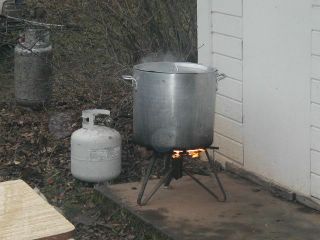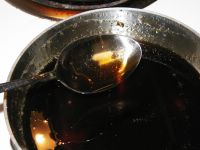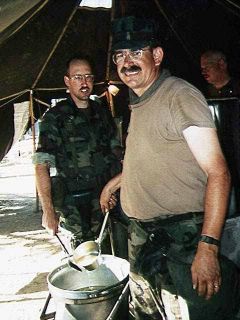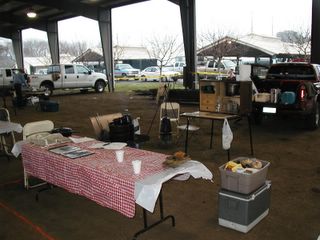This recipe is a quick alternative to working with yeast dough in camp. As the name implies, they’re (relatively) quick. And they make a great accompaniment to your next campfire breakfast.
I’ve tried to skip the step where you pat the dough into a rectangle, spread melted butter and cinnamon-sugar filling and roll into a log. I’ve found that this can be a bit much work in camp.
But I find the extra step is worth the effort. I ran out of time while preparing this recipe at the
Winter Camp Cookoff last month. So, instead of forming the rolled cinnamon log as I had in Navy bakeries, I formed biscuits.
To form biscuits, I patted the dough into a large circle on a floured board and sprinkled the cinnamon-sugar mixture over the dough. I then pressed the sugar into the dough and cut 2-inch biscuits. These biscuits were just as popular as my
chili on the cold, foggy day of the cookoff.
On another occasion, I formed a cinnamon biscuit "sandwich." This time I patted the dough into two rectangles, each about half the width as the recipe calls for. I then sprinkled the cinnamon-sugar mixture over the first piece and folded the second piece on top of it. After pressing the two pieces together, I cut biscuits as before. I encountered a small problem: The two halves separated as I cut the biscuits.
Use the first alternative if you're pressed for time or if you don't see the need to impress anyone with the spiraling coils of traditional cinnamon buns.
QUICK CINNAMON BUNS WITH BUTTERMILK ICINGThis recipe is adapted for Dutch ovens from the May/June 2002 Cook’s Illustrated.
1 tablespoon unsalted butter, melted
Filling:
3/4 cup packed dark brown sugar
1/4 cup granulated sugar
2 teaspoons cinnamon
1/8 teaspoon cloves
1/8 teaspoon table salt
1 tablespoon unsalted butter, melted
Biscuit Dough:
2-1/2 cups all-purpose flour
2 tablespoons granulated sugar
1 1/4 teaspoons baking powder
1 1/4 teaspoons baking soda
1 1/4 teaspoons table salt
1 1/4 cup buttermilk
6 tablespoons unsalted butter, melted
Icing:
2 tablespoons cream cheese
2 tablespoons buttermilk
1 cup confectioner's sugar
Use a 10-inch Dutch oven for this recipe. Ignite 27 charcoal briquettes and let them burn until they are barely covered with ash, about 20 minutes. For a 425-degree oven, you’ll need 9 briquettes underneath and 18 on top of the oven. Pour 1 tablespoon melted butter in 10-inch Dutch oven; brush to coat bottom and sides of oven.
To make cinnamon-sugar filling: Combine sugars, spices and salt in small bowl. Add 1 tablespoon melted butter and stir with fork or fingers until mixture resembles wet sand; set filling mixture aside.
To make biscuit dough: Whisk flour, sugar, baking powder, baking soda and salt in large bowl. Whisk buttermilk and 2 tablespoons melted butter in measuring cup or small bowl. Add liquid to dry ingredients and stir with wooden spoon until liquid is absorbed (dough will look very shaggy), about 30 seconds. Transfer dough to lightly floured work surface and knead until just smooth and no longer shaggy.
Pat dough with hands into 12 by 9-inch rectangle. Brush dough with 2 tablespoons melted butter. Sprinkle evenly with filling, leaving 1/2-inch border of plain dough around edges. Press filling firmly into dough.
Using bench scraper or metal spatula, loosen dough from work surface. Starting at long side, roll dough, pressing lightly, to form a tight log. Pinch seam to seal.
Roll log seam-side down and cut evenly into eight pieces. With hand, slightly flatten each piece of dough to seal open edges and keep filling in place. Place one roll in center of prepared Dutch oven, then place remaining seven rolls around perimeter of oven.
Brush with 2 tablespoons remaining melted butter. Bake until edges are golden brown, 23 to 25 minutes. Remove lid and cool buns in Dutch oven.
To make icing and finish buns: Whisk cream cheese and buttermilk in large bowl until thick and smooth (mixture will look like cottage cheese at first). Sift confectioners’ sugar over; whisk until smooth glaze forms, about 30 seconds. Spoon glaze evenly over buns; serve immediately.
NOTES: Melted butter is used in both the filling and the dough and to grease the oven; it’s easiest to melt the total amount (8 tablespoons) at once and measure it out as you need it. The finished buns are best eaten warm, but they hold reasonably well for up to 2 hours.
























